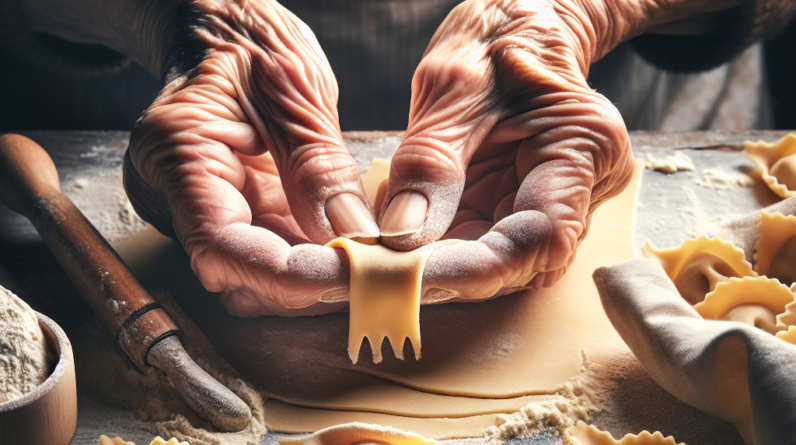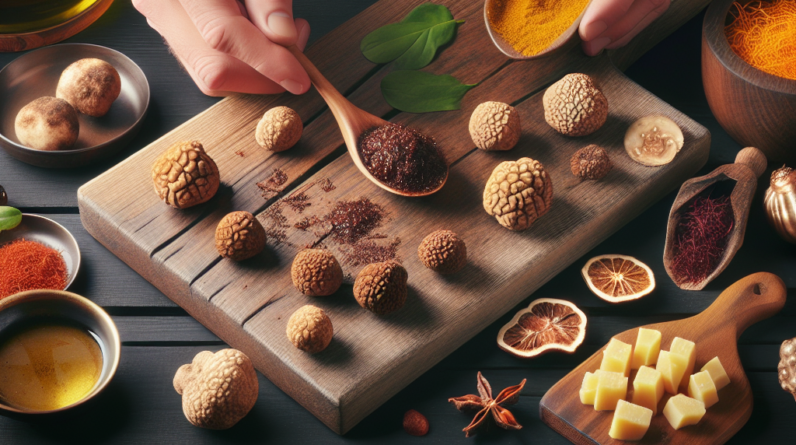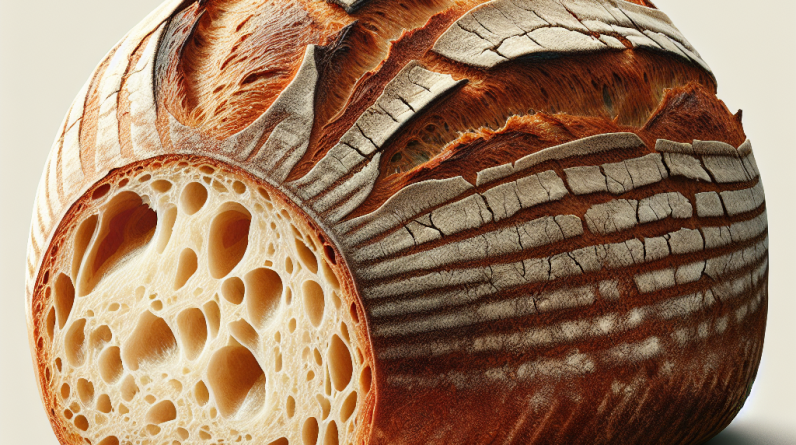Have you ever wondered about the secret behind a perfectly creamy and smooth risotto? Well, look no further, because we are here to guide you through the traditional way of preparing this Italian classic. Brace yourself for a culinary adventure as we uncover the key ingredients, techniques, and tips that will elevate your risotto game to new heights. Get ready to tantalize your taste buds and impress your dinner guests with a velvety and delectable dish that will leave them begging for more. So, grab your apron and let’s get cooking!
Choosing the Right Rice
When it comes to making the perfect risotto, choosing the right type of rice is crucial. Three popular varieties that are commonly used for risotto are Arborio rice, Carnaroli rice, and Vialone Nano rice. Each of these rice types has unique characteristics that contribute to the final texture and flavor of the dish.
Arborio Rice
Arborio rice is perhaps the most well-known rice for making risotto. It is a short-grained rice that is known for its ability to absorb liquid while remaining firm to the bite. This creates the classic creaminess that is characteristic of a good risotto. Arborio rice also releases starch during cooking, giving the risotto a smooth and velvety texture. Its ability to maintain its shape makes it an excellent choice for a traditional risotto.
Carnaroli Rice
Carnaroli rice is often referred to as the “king of rice” due to its high quality and excellent texture. It has slightly longer grains compared to Arborio rice, which allows it to absorb even more liquid without becoming mushy. This rice variety retains its firmness while still releasing starch, resulting in a rich and creamy risotto. Carnaroli rice is a great choice if you want a risotto with a perfect balance of creaminess and a slightly firmer bite.
Vialone Nano Rice
Vialone Nano rice is another popular choice for making risotto, especially in the Veneto region of Italy. It has shorter, plump grains that absorb liquid well and release starch during cooking. Vialone Nano rice has a slightly nutty flavor, which can add an extra dimension to your risotto. This rice variety is often favored for its ability to create a risotto with a slightly creamy texture while still maintaining a distinct grainy bite.
Sautéing the Aromatics
Before diving into the cooking process, it is important to properly sauté the aromatics to build a flavorful base for the risotto. The key aromatics are onions or shallots and garlic. Additionally, you have the option to use either butter or olive oil to sauté these ingredients.
Onions or Shallots
Onions or shallots play a crucial role in providing a sweet and savory flavor to the risotto. They can be thinly sliced or finely chopped, depending on your preference. Sautéing the onions or shallots over medium heat allows them to soften and release their natural sweetness, which helps to enhance the overall taste of the risotto.
Garlic
Garlic adds a fragrant and aromatic flavor to the risotto. It is important to finely mince the garlic cloves to ensure that the flavor is evenly distributed throughout the dish. Sautéing the garlic along with the onions or shallots will help to mellow its sharpness and infuse the risotto with a delightful garlicky aroma.
Butter or Olive Oil
The choice between butter and olive oil is a matter of personal preference. Butter imparts a rich and creamy flavor to the risotto, while olive oil provides a more light and fruity taste. Both options work well, so choose whichever you prefer or experiment with both to find your favorite flavor profile. Whichever you choose, make sure to heat it in the pan before adding the onions or shallots and garlic.

Adding the Wine
Once the aromatics have been sautéed to perfection, it’s time to add the wine. While adding wine is not mandatory, it adds a depth of flavor and acidity that complements the creaminess of the dish.
Dry White Wine
Dry white wine is typically used in risotto as it adds a bright and acidic note to balance the richness. The alcohol in the wine evaporates during cooking, leaving behind a flavor-enhancing essence. Choose a wine that you enjoy drinking, as the flavors will infuse into the risotto. It’s important to note that the acidity of the wine helps break down the starch in the rice and aids in achieving the desired creamy texture.
Choosing the Right Wine
When selecting a wine, aim for one that is dry and unoaked. A good rule of thumb is to choose a wine that you would enjoy drinking on its own. Popular options include Sauvignon Blanc, Pinot Grigio, or Chardonnay. However, feel free to experiment with different wines to find your perfect pairing. Remember that the wine should complement the flavors of the dish without overpowering it.
Cooking the Rice
Now that the aromatics and wine have been added, it’s time to cook the rice. This step is key in achieving the perfect texture and creaminess of a classic risotto.
Adding the Stock
To cook the rice, you will need to gradually add hot stock to the pot. The stock can be chicken or vegetable-based, depending on your dietary preferences. Traditionally, a homemade stock is recommended for the best flavor, but store-bought options can also work well. The hot stock is added gradually to the rice, allowing it to absorb the liquid while releasing starches that create the creamy consistency.
Cooking Time
The cooking time for risotto can vary depending on the rice variety and personal preferences. Typically, the rice is simmered for around 20 to 30 minutes in total. However, it is best to follow the instructions on the rice packaging and test the rice for doneness during the cooking process. The rice should be cooked until it is al dente, meaning it is tender with a slight firmness at the center.
Stirring the Rice
Stirring the rice while it cooks is an essential step in creating a creamy and smooth risotto. Regularly stirring the rice helps release the starches, which contribute to the desired velvety texture. The key is to stir gently but consistently to prevent the rice from sticking to the bottom of the pan. This process also helps to ensure that the rice cooks evenly and absorbs the liquid uniformly.

Maintaining Creaminess
To achieve the ultimate creaminess in your risotto, there are a few additional steps you can take towards the end of the cooking process.
Adding Butter
Adding a pat of butter towards the end of cooking can contribute to the richness and creaminess of the risotto. The butter adds a silky mouthfeel and enhances the overall flavor. Simply stir in the butter until it is fully melted and incorporated into the risotto before serving.
Adding Cheese
Cheese is another fantastic way to add creaminess and depth of flavor to your risotto. Traditional Italian cheeses like Parmesan or Grana Padano work exceptionally well. The cheese is typically grated or finely shredded and added towards the end of cooking, ensuring it melts into the risotto. Stir the cheese into the risotto until it is fully melted and the risotto becomes even creamier.
Using Chicken or Vegetable Stock
The choice of stock also plays a role in achieving a creamy risotto. Chicken stock tends to lend a richer and fuller flavor, while vegetable stock adds a lighter and more delicate taste. Both options work depending on personal preference. Remember to choose a high-quality stock or make your own for the best flavor.
Achieving the Right Texture
The texture of a risotto is a defining factor in its success. It should be creamy, yet each grain of rice should have a slight bite to it.
Al Dente
To achieve the perfect risotto texture, strive for the ideal state of al dente. This means that the rice should be cooked until it is tender, but still has a slight firmness at the center. It should not be mushy or overly soft. Testing the rice for doneness by tasting a few grains during the cooking process is essential to ensure it reaches the desired texture.
Creaminess
The creaminess of risotto comes from the gradual absorption of liquid and the release of starches from the rice. This process creates a velvety texture that coats each grain of rice. The creaminess should not be too thin or too thick, but rather a luscious consistency that lightly clings to the rice.
Firmness
While the risotto should be creamy, it’s also important to maintain a firmness in the grains. This firmness adds a delightful textural element to the dish, preventing it from becoming mushy. The individual grains should still have enough structure without being undercooked. Striking the balance between creaminess and firmness is key to achieving the right texture in a risotto.

Flavor Enhancements
To elevate the flavor profile of your risotto, consider adding some complementary ingredients during the cooking process or as garnishes.
Fresh Herbs
Fresh herbs can brighten up the flavors of a risotto and add a pop of freshness. Popular choices include parsley, basil, or thyme. Finely chop the herbs and stir them into the risotto just before serving to preserve their vibrant flavors and colors.
Lemon Zest
The zest of a lemon can add a bright and refreshing note to the risotto. Use a microplane or a fine grater to zest the outer yellow portion of the lemon peel. The zest can be added towards the end of cooking or used as a garnish. Its citrusy aroma and tanginess can bring a new dimension of flavor to the risotto.
Parmesan Cheese
In addition to adding creaminess, Parmesan cheese also adds a savory and nutty flavor to the dish. Grate or finely shred a generous amount of Parmesan cheese and incorporate it into the risotto just before serving. The cheese will melt into the risotto, intensifying its taste and aroma.
Serving Suggestions
Once your risotto is cooked to perfection, it’s time to plate and serve. Consider the following suggestions for garnishes, pairings, and accompaniments to enhance your dining experience.
Garnishes
Garnishing your risotto can add a touch of elegance and visual appeal. A sprinkle of fresh herbs, a drizzle of extra virgin olive oil, or a sprinkle of grated Parmesan cheese makes for simple yet tasteful garnishes. You can also get creative with additional toppings such as crispy pancetta, toasted pine nuts, or a shaving of truffle for a luxurious twist.
Pairings
Risotto is a versatile dish that pairs well with a variety of proteins, vegetables, or seafood. Some popular pairings include grilled chicken, roasted vegetables, seared scallops, or sautéed mushrooms. Consider the flavors and textures of both the risotto and your chosen pairing to ensure they complement each other harmoniously.
Accompaniments
To complete the meal, consider serving your risotto with a side salad or a crusty bread for some added texture and freshness. A crisp green salad with a light vinaigrette or a warm loaf of bread with a pat of butter can provide a delightful contrast to the creamy and rich risotto.
Common Mistakes to Avoid
While making risotto is a straightforward process, there are a few common mistakes that can hinder the final result. By being aware of these pitfalls, you can ensure a successful and delicious risotto every time.
Overcooking the Rice
One of the biggest mistakes when making risotto is overcooking the rice. It is important to monitor the cooking time and check the doneness of the rice regularly. Overcooked rice becomes mushy and loses its desirable texture. The rice should be tender with a slight firmness at the center when it is done.
Skipping the Wine
While wine is not a mandatory ingredient in risotto, skipping it can result in a less flavorful dish. Wine adds acidity and depth of flavor that complements the creaminess of the risotto. It also aids in breaking down the starches in the rice, contributing to the desired creamy texture. If you choose to omit the wine, consider adding a splash of lemon juice for some acidity.
Using the Wrong Rice
Using the wrong type of rice can greatly affect the texture and overall success of your risotto. Certain rice varieties, such as long-grain or converted rice, do not have the necessary starch content to create a creamy risotto. It is important to choose a short-grain rice variety, such as Arborio, Carnaroli, or Vialone Nano, that can absorb liquid while maintaining its shape and releasing starches.
Adding Variations
While a traditional risotto is already delicious on its own, there are endless possibilities for adding variations and experimenting with different ingredients. Here are a few popular variations to try:
Mushroom Risotto
Mushroom risotto is a classic variation that adds earthy flavors and a meaty texture to the dish. Sauté a mixture of mushrooms such as button, cremini, or shiitake and incorporate them into the risotto during the cooking process. The mushrooms will lend their flavor and create a delightful combination with the creamy rice.
Seafood Risotto
Seafood risotto is a luxurious option for seafood lovers. The risotto can be enhanced with the addition of shrimp, scallops, mussels, or any other seafood of your choice. Sear the seafood separately and gently fold it into the risotto towards the end of cooking. The seafood not only adds a pleasant taste but also provides a visually stunning presentation.
Vegetable Risotto
Vegetable risotto is a great option for vegetarians or those looking for a lighter variation. Incorporate seasonal vegetables like asparagus, peas, or roasted butternut squash into the risotto. Sauté or roast the vegetables before adding them to the risotto to enhance their flavors. The result is a colorful and flavorful vegetable-forward dish.
In conclusion, preparing a creamy and smooth risotto requires attention to detail and the right techniques. Choosing the right rice variety, sautéing the aromatics, adding the right wine, and cooking the rice correctly are key steps in achieving the desired texture and flavor. Adding butter, cheese, and the right stock can enhance the creamy consistency. Don’t forget to include flavor enhancements like herbs, lemon zest, and Parmesan cheese to elevate the taste. When serving, consider garnishes, pairings, and accompaniments to complete the dining experience. By avoiding common mistakes and experimenting with variations, you can truly master the art of making a delicious risotto. So let’s get cooking and enjoy the creamy and smooth delight of a traditional risotto!










